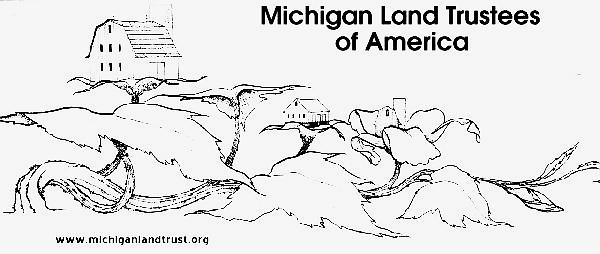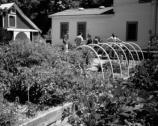

The Peace of Wild Things
 When despair for the world grows in me
When despair for the world grows in me
and I wake in the night at the least sound
in fear of what my life and my children's lives may be,
I go and lie down where the wood drake
rests in his beauty on the water, and the great heron feeds.
I come into the peace of wild things
who do not tax their lives with forethought
of grief. I come into the presence of still water.
And I feel above me the day-blind stars
waiting with their light. For a time
I rest in the grace of the world, and am free.
Wendell Berry
MLT Newsletter
Spring 2003
(end of "flagrant editorial digression") Jon Towne

MLT has been financially assisting the Kalamazoo Community Gardens Iniative in Kalamazoo, and I think it is money well spent!
 The 2002 growing season provided
KCGI with many opportunities for growth and evolution, which were, of
course, sprinkled with a few obstacles! Once again, the Wall St.
Community Garden was a huge success, with around twelve Vine
Neighborhood residents growing food in eight gardening plots. For the
first time, KCGI was able to supplement The Comstock Growers Co-op’s
annual vegetable starter plant donations with our own plants started
from seed in a member’s greenhouse. Gardeners chose among many
different types of peppers, tomatoes, squash, onions, broccoli, herbs,
and greens, as well as plants they brought on their own. The garden
yielded so much that around 15 pounds of produce was donated to Loaves
& Fishes!
The 2002 growing season provided
KCGI with many opportunities for growth and evolution, which were, of
course, sprinkled with a few obstacles! Once again, the Wall St.
Community Garden was a huge success, with around twelve Vine
Neighborhood residents growing food in eight gardening plots. For the
first time, KCGI was able to supplement The Comstock Growers Co-op’s
annual vegetable starter plant donations with our own plants started
from seed in a member’s greenhouse. Gardeners chose among many
different types of peppers, tomatoes, squash, onions, broccoli, herbs,
and greens, as well as plants they brought on their own. The garden
yielded so much that around 15 pounds of produce was donated to Loaves
& Fishes!
KCGI made a concerted effort to reach out to local organizations in order to fulfill our name and serve as the community garden initiators. With the help of a graduate student we developed a spring/summer garden club program at the Lake St. Boys & Girls Club. This was a weekly after-school and summer program for 4-15 children, ages 7-14. It began with educational games, gardening basics and other indoor activities, including the much anticipated snack time. As the weather warmed up we started seeds, visited the greenhouse and just played outside! KCGI and the Edison Environmental Academy KNC Garden Club built five raised beds at the school; gardening space was shared between the two groups, proving to work out nicely. Children from the Boys & Girls Club transplanted their seedlings into the garden over a couple of weeks and from then on, the main activity was watering (the plants as well as each other, and occasionally, not much to our surprise, the teachers).
 We also began dialogue with the
Eastside and Edison Neighborhood Associations. We purchased a plot of
land on Horace St. in the Eastside and received a United Way grant
through the Association to build a garden with the Youth Action
Council. Unfortunately, due to some rocky neighbor relations with the
homeowners next door, we had to postpone the project until this year.
Thus, we continue to work with the Eastside Neighborhood Association in
2003 and are looking forward to a beautiful garden this summer!
We also began dialogue with the
Eastside and Edison Neighborhood Associations. We purchased a plot of
land on Horace St. in the Eastside and received a United Way grant
through the Association to build a garden with the Youth Action
Council. Unfortunately, due to some rocky neighbor relations with the
homeowners next door, we had to postpone the project until this year.
Thus, we continue to work with the Eastside Neighborhood Association in
2003 and are looking forward to a beautiful garden this summer!
A Jewish youth camp, Camp Tavor, contacted KCGI last summer in hopes that we had some volunteer opportunities for teenagers. It just so happened that we needed some extra hands building some coldframes, so we invited them to spend an afternoon of learning and working with us. The kids took so much initiative that together, we built nine, 3x2’ coldframes made of wood and greenhouse plastic! They had a lot of fun and we are all looking forward to working more this year.
As for the Union St. Community Garden, we had only four gardeners, none of whom were from the Northside Neighborhood. This lack of interest in certain parts of the city is by far the most challenging part of our undertakings. We attempted to reach out to the Northside Association for Community Development, schools, and a neighboring church, but perhaps, were not persistent enough. This year we plan to put more energy into reaping more interest in the Northside.
Our educational series grew quite a bit from the previous year. We provided the community with free workshops on organic gardening formulas, seed saving, and tomato canning. The gardening formulas workshop was held at the Wall St. garden and eight people came to learn how to make homemade remedies and fertilizers for their gardens. In September we held a canning workshop at the WMU’s Lee Baker Farmhouse for about ten people. Using the water bath and pressure canning methods, we canned 30 pints and ten quarts of donated tomatoes as well as KCGI homegrowns. In November at the Woodward School, KCGI member and Master Gardener, Jackie Smith taught people to save vegetable seeds for next year’s garden. This year we are expanding our educational series to monthly workshops from March to November, which we received a grant for from the Kalamazoo Community Foundation.
The last mini-grant was used to purchase various tools and to pay land taxes on our four pieces of property As always, we are very appreciative of the Michigan Land Trustees for helping to sustain KCGI – we could not continue to pursue our mission without your support. We would like to acknowledge that you have supported our vision for a healthier Kalamazoo from the very beginning and we are indebted.





The following article was writter by Jan Ryan, MLT board member.
MUSINGS OF A PLANT PEST INSPECTOR
Jan Ryan
Last summer and fall I spent a total of six weeks living out of motels in the Detroit area. I was helping to coordinate a survey of the emerald ash borer, a newly discovered exotic beetle attacking ash trees in southeast Michigan. The beetle is native to Asia and probably arrived in wooden packing material through the Detroit shipyards.
When I first received the assignment to work on this project, I packed my bags grudgingly, thinking of all the things I had planned to do during the month of September. I now must admit the project was a most interesting and eye-opening experience. As I normally work alone much of the time, the chance to interact with entomologists and foresters from all over the country who came to help and learn was a real treat. Together we shared in the perversity of inspection work: the most interesting and exciting things are always the most horrific.
Emerald ash borer is indeed a horrific threat. Like chestnut blight, Dutch elm disease and the more recent Asian long-horned beetle, this pest kills its host. It will attack any of our native ash species, and has already destroyed millions of trees in the estimated 5-8 years it’s thought to have been here. While this story is dramatic, it is, unfortunately, far from unique. Recent increases in global trade through agreements like NAFTA and GATT have meant the arrival of foreign organisms at unprecedented rates. Most are hitchhikers, coming in with cargo, plants, crating, packing material, ballast water and dunnage (the wooden braces used to hold cargo on ships). From 1985-1996, USDA made more than 5,800 interceptions of exotic insects on wood articles at US ports of entry. Though impressive, these inspections are far from fool proof, as less than 2% of cargo is inspected.
Not all exotic species become pests or are considered invasive. Foreign organisms may be particularly threatening because they have no evolutionary history here. Often this means there are no predators, parasites or pathogens to help keep them in check. In addition, native species have not had the chance to evolve defenses against foreign invaders. According to Bill Mattson, Insect Ecologist with USDA in East Lansing and prominent author on plant-insect interactions, many exotic pests will forever alter natural ecosystems in ways that we are yet to even understand. A USDA official at an entomology conference I attended last year pointed out a more tangible change. This is the rapid loss of regional pride and identity occurring due to the pollution of unique natural habitats; sort of a natural systems parallel to the invasion of cities and towns by chain stores. Eventually, it seems, we will all have the same junk.
Besides ecological costs of exotic pests, economic costs are staggering. Most obvious is the chronic spraying of toxic pesticides to control organisms perpetually out of balance with nature. This may include mandatory treatment of commodities being moved across quarantine lines. For instance, all spruce and fir trees leaving Michigan must be sprayed for gypsy moth, regardless of the pest status. Inspections and other regulatory work at both the state and federal level are also expensive, especially when attempts at eradication are made. In 2000, the annual budget for citrus canker eradication in the state of Florida was $145 million. A request in to USDA for the elimination of emerald ash borer is in the neighborhood of $50 million. The costs of not stopping the beetle would exceed this in short order.
These enormous ecological and economic costs of global trade are, I believe, a strong argument for the building of local economies. The amount of regulation, inspection and fumigation necessary to prevent pest introductions at our current level of trade seems to me (like the prevention of terrorism) an impossibility. Growers, producers or buyers who engage in local trade only within their respective bioregions do not contribute to the threat of new introductions, either here or overseas. On the other hand, the costs of exotic pests are not only externalized, they are being paid through the irreversible destruction of natural resources.
Late Thoughts on the Schools of Homesteading Reunion
The Michigan Land Trustees and Land Trust Schools of Homesteading held a reunion. More than 150 former students, and their families, friends and hangers-on, gathered for a weekend at the Land Trust Farm in Bangor, Michigan. It was pleasant time spent. The reunion was back in the summer of 1998.
For most of those in attendance, it was a nostalgia trip. We conversed and reminisced and ate organic for two days before dispersing. Most everyone agreed that our time as students on either farm had been profound and pivotal. But there was a pall over the event. For me, the weekend was an uncomfortable reminder of my failure to become as self-reliant as I thought most of us were destined to become back in 1980. I suspect that the majority of former homesteading students succumbed to the relative ease of affluence. We were supposed to know better.
If the back-to-the-land movement had a vanguard it’s already came and went. The cultural shift in which small communities strive for ecologic and empowered self-reliance in work, art, and living is more modest than I ever imagined. As homesteading students, we were to pick up chicken wire and garden trowel and eek out a humble existence on a small piece of land: live simply, simply live—all the while maintaining a rich, creative [and perhaps intellectual] life. As middleclass, college-educated youth, turning away from consumption, purchases, and waste meant becoming compelling role models. Society as we know it would then have had to contend with a growing segment of just, creative, and resourceful communities of small land owners that would eventually influence regions and affect the nation. It was a vision of Jeffersonian democracy. It didn’t happen. Or, rather, it hasn’t happened yet.
The window of opportunity was wide open. Well into the mid-1980’s, ten acres could be had by land contract and a minimum wage. My wife and I bought a few acres of north facing slope and built a house. For several years we fumbled towards self-reliance. We grew vegetables, raised chickens, planted hundreds of trees, and added-on to our home as we added on to our family. We were autodidactic and strong. But then something happened. We prospered. In no time, our subdued suburban track-house dwelling roots belched back with a vengeance. These days, save for firewood, fresh eggs, and community activism, we’re just suburbanites. On the plus side, all the trees we’ve planted have come up. Being surrounded by green space means that our sons can pee outside with impunity.
The painful part of the homesteading schools’ reunion was that for most of us it was only a look back. We were unable to fully put to use the skills and tools that were dropped in our laps. I have an affinity closer to the crass, banal aspects of modern times as seen on TV. I left the reunion feeling sheepish and embarrassed.
I asked Maynard Kaufman, farmer and co-founder of the Land Trust School of Homesteading, whether he was bitter that so many of his students failed the mission. He was philosophical, “That may be so, but here you have a gathering of really sweet people.”
That much was true. Virtually everyone in attendance appeared kindly and conscientious. And, in the whole scheme of things, those 150 people present probably generate less distress and effluence than 150 of their counterparts anywhere in the nation. It’s just that we didn’t take it far enough. Ecology and self-reliance will be driven by desperation and not deliberation.
—Mike Phillips, Class of 1980